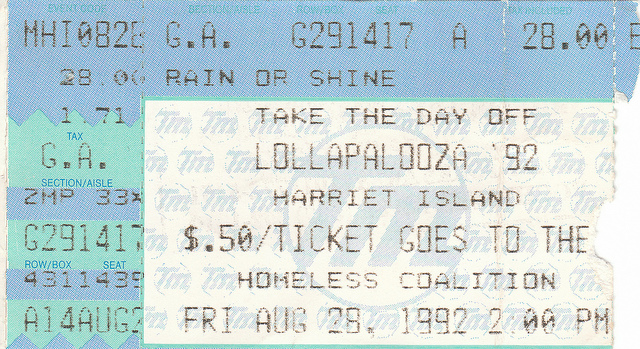The 90s saw Bill Clinton act like a naughty boy and Sharon Stone play the naughtiest of girls, treating Basic Instinct fans to some “behind the scenes footage.”
Along with The Fresh Prince reigning supreme, the 90s introduced us to Vincent Vega and Jules Winnfield, two hitmen with a penchant for philosophical musings. Buffy was busy slaying vampires, Mulder and Scully investigated unexplained cases known as “X-Files,” and Zach Morris was repeatedly saved by the bell.
And the music, oh the music, where to even begin.
Similar to the days of Hendrix and The Doors, grunge, sometimes referred to as the Seattle sound, celebrated and embraced rebellion in its most artistic form. This subgenre emerged during the mid-1980s in the state of Washington, with Seattle, or “Rain City,” producing a string of seminal artists.
Although Green River, a pioneering group consisting of four Seattleites, had little commercial impact across the U.S, the group is noted for instigating the grunge movement. “Come on Down,” the band’s first record, is widely regarded as the first grunge record. Guitarist Stone Gossard and bassist Jeff Ament would go on to join Pearl Jam, while Mark Arm would go on to become the vocalist for Mudhoney, two of the 90’s most influential bands.
Just as Germany demolished The Berlin Wall, the proverbial barrier confining grunge to Seattle also fell, with California and other parts of the U.S. embracing the subgenre. Inspired by hardcore punk and heavy metal of the early 1970s, grunge introduced us to heavily distorted guitars and growling vocals.
Apathetic, angst-laden lyrics, a total rejection of theatrics, the sub-genre had it all, and Nirvana, Soundgarden, Alice in Chains and the aforementioned Pearl Jam all helped spearhead the new wave of grunge.
With “Achy Breaky Heart” by Billy Ray Cyrus on loop, pop music was in a funk, and Generation X cried out for some musical medication. Grunge, now a global phenomenon, wasn’t a trend—it was an expression of cultural, and social principles.
Feminism, liberalism, anti-authoritarianism, these movements and ideologies formed the foundation for grunge to flourish. Kurt Cobain and Eddie Vedder, to name just two, represented the new wave of frontmen. Incongruous and indignant, 90’s grungers prided themselves on intelligent, non-conforming lyrics.
Again, just like the 1960’s, grunge successfully remodelled paradigms that were blasé and trivial in content. Some sceptics labelled grunge nihilistic and self-obsessed, however, it was anything but.
On the contrary, existentialism formed the foundation on which bands like Soundgarden and Pearl Jam thrived upon. With lyrics discussing an individual’s ability to define their own reality, grunge had substance.
By addressing prodigious themes, the sub-genre avoided materialistic musings. Peal Jam’s “Ten,” released the same year as Nirvana’s “Nevermind,” focused on domestic abuse, education, or lack of, and the persecution of the intellectually challenged. While Alice in Chains spoke about substance abuse, Nirvana specialised in the themes of detachment and the rejection of orthodox values. Soundgarden, quite possibly the most existentialistic band of the ’90s, attempted to establish purpose in a world dominated by prosaic practicalities.
Conceived and created in 1991 by Perry Farrell, Jane’s Addiction extroverted frontman, Lollapalooza sought to combine music and critical thinking.
Through the promotion of organic eating and voter registration, the music festival, unlike Woodstock, for example, travelled across the United States and Canada, promoting the importance of individualism and equal rights.
1991 also saw the creation of grunge’s first ever supergroup, Temple of the Dog. Uniting to pay tribute to Andrew Wood, the Mother Love Bone vocalist who died 25 years ago from a heroin overdose, members of Pearl Jam and Soundgarden gave us “Hunger Strike,” one of the greatest grunge power ballads of all time.
Although Metallica were not part of the grunge movement, their eponymous LP, more commonly referred to as “The Black Album,” was particularly influential, capturing the imagination of millions around the globe. A combination of brash, highly accessible hooks and devilish lyrics established the Los Angeles outfit as one the most important metal band of the ’90s.
Along with the rise of the Californian group, largely thanks to enigma known as Slash, Guns N’ Roses, the rock band formed in 1985, went on to dominate the music scene. “Use Your Illusion I & II,” released in September of 91, were simply awesome. With singles including the scintillating “You Could Be Mine” and the sprawling epic “November Rain,” vocalist Axl Rose, lead guitarist Slash, rhythm guitarist Izzy Stradlin, bassist Duff McKagan, and drummer Steven Adler specialised in the creation of musical masterpieces.
The mid ‘90s brought the rise of Britpop, with Blur, Pulp and Oasis engaging in an artistic scuffle with American neo-punk bands, mainly Green Day, Blink 182, and The Offspring.
As the decade drew to a close, having basically accepted commercialisation and conformity, the quality of rock music started to deteriorate. However, as that horrendous cliché goes, all good things must come to an end. The ’90s, especially 1991-1994, were simply brilliant, largely because artists and singers wished to right the wrongs of the 1980’s, a decade in which the music industry went very much astray.
Disillusioned and hungry for change, the grunge movement—and broader ’90s wave of rock—resonated with a generation of young men and women.
Impregnable, impenetrable, inviolable, call it what you will, grunge forcefully replaced the all too malleable rock of the late 80’s. By injecting some much needed soul into the genre, grunge acted as a musical minister, eventually marrying explicit exasperation with sensitivity and sincerity.
Relephant:
10 Videos: Nostalgia for early 90s Pearl Jam.
Author: John Glynn
Editor: Catherine Monkman
Photo: Dave Toedter/Flickr, Wikimedia













Read 0 comments and reply